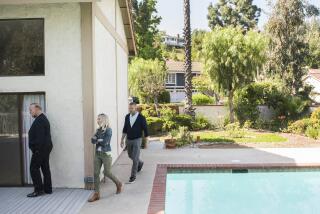Retail Dust-Up Seen for O.C., Inland Empire
- Share via
Southern California’s retail sales are growing at a brisk pace, with Riverside and San Bernardino counties poised to muscle past more-affluent Orange County, according to a study by the Los Angeles County Economic Development Corp.
Los Angeles County will remain the region’s sales champion, but the predicted move by Riverside-San Bernardino into the No. 2 spot next year is one of several major changes brewing on the local retail scene, said Jack Kyser, chief economist of the LAEDC, which is scheduled to release its retail study today.
For the next few years, retail sales in the five-county region studied by the Los Angeles-based business development group will continue to lag behind the blistering double-digit growth of 1999 and 2000. But Southern California will outpace the rest of the state in sales increases, the study said.
“It’s healthy growth, and it reflects the continued population growth in the region” as well as new retail concepts to battle chronic shopper boredom, Kyser said.
Retail sales this year are projected to rise 6.4% to $149.1 billion in Los Angeles, Orange, Riverside, San Bernardino and Ventura counties, the report said. Next year, retail sales are expected to hit $159.9 billion, up 7.3%, followed in 2005 by 7% growth to $171 billion, according to the study, written by Kyser and LAEDC economist George Huang.
The retail sales growth rates in Southern California compare with state forecasts of 4.6% for 2003, 6.5% for 2004 and 6.3% for 2005.
Rapid population growth in the Inland Empire, combined with retail development, will push retail sales in the Riverside-San Bernardino area slightly ahead of Orange County’s next year, the report said, projecting $34.2 billion in sales for Riverside-San Bernardino and $33.4 billion for Orange County in 2004. Los Angeles County retail sales will reach $84.3 billion next year, the report predicted.
The study found that along with the expected growth will come a “tectonic shift” in local retailing marked by the addition of Wal-Mart Stores Inc.’s all-encompassing Supercenters, the expansion of some relatively new-to-the-Southland names, such as Kohl’s and Dillard’s department stores and Lowe’s home improvement stores, and the declining fortunes of mid-range retailers and strip malls. Consumers are interested in an odd mixture of low-cost and high-end merchandise, squeezing out the middle-of-the-road retailer, Kyser said.
“The ever-expanding customer base does not automatically mean increased sales for all retailers, however. The retail industry is a brutal war zone, and the fights will be more intense in the coming years,” the report said.
Among the LAEDC’s retail predictions:
* Community opposition and problems finding big sites will keep Wal-Mart from opening as many Supercenters as it would like.
* An oversupply of stores will hurt older retail centers.
* As developers explore retail ideas, major malls will be forced to renovate to stay competitive.
* Some older downtown areas, including those of Los Angeles and Long Beach, could become retail hot spots thanks to increasing residential development.
More to Read
Inside the business of entertainment
The Wide Shot brings you news, analysis and insights on everything from streaming wars to production — and what it all means for the future.
You may occasionally receive promotional content from the Los Angeles Times.










